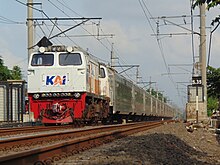
Back ইন্দোনেশিয়ার রেল পরিবহন Bengali/Bangla Schienenverkehr in Indonesien German Ferrocarril en Indonesia Spanish Transport ferroviaire en Indonésie French Indonézia vasúti közlekedése Hungarian Transportasi rel di Indonesia ID インドネシアの鉄道 Japanese Pengangkutan rel di Indonesia Malay Spoorwegen in Indonesië Dutch การขนส่งระบบรางในประเทศอินโดนีเซีย Thai
| Indonesia | |
|---|---|
 Argo Lawu train in Tambun | |
| Operation | |
| National railway | |
| Statistics | |
| Ridership | 429.2 million (2019)[1] |
| Freight | 995.5 million tonnes (2015, as of October)[2] |
| System length | |
| Total | 8,260 kilometres (5,130 mi)[3] |
| Electrified | 621 kilometres (386 mi) |
| Track gauge | |
| Main | 1,067 mm (3 ft 6 in) |
| Standard gauge 1,435 mm (4 ft 8+1⁄2 in) | 107.7 kilometres (66.9 mi) |
| Electrification | |
| Main | 1.5 kV DC overhead line |
| Features | |
| Longest tunnel | Sasaksaat Tunnel 949 m (3,114 ft)[4] |
| Longest bridge | Cikubang Bridge 300 m (980 ft)[5] |
| Highest elevation | 848 m (2,782 ft) |
| at | Nagreg railway station[6] |
| Lowest elevation | 1 m (3 ft 3 in) |
| at | Surabaya Pasar Turi railway station[6] |
The majority of Indonesia's railways are on Java, used for both passenger and freight transport. There are three noncontinuous railway networks in Sumatra (Aceh and North Sumatra; West Sumatra; South Sumatra and Lampung) while two new networks are being developed in Kalimantan and Sulawesi.[7][8] Indonesia has finalized its plan for a national railway network recently. According to the plan, 3,200 km of train tracks that will criss-cross the islands of Sumatra, Java, Kalimantan, and Sulawesi, it has been touted as the most extensive railway project in Indonesia since its independence from the Dutch in 1945.[9] Indonesia targets to extend the national railway network to 10,524 kilometres by 2030. As of September 2022, the network spans 7,032 km.[10]
Urban railway exist in form of commuter rail in all provinces and metropolitan areas of Java – notably in Jakarta – as well as Medan, North Sumatra. New mass rapid transit and light rail transit system are currently being introduced in Jakarta and Palembang, South Sumatra.
Despite Indonesia having a left-hand running for roads, most of the railway lines use right-hand running due to Dutch legacy.
Indonesia's rail gauge is 1,067 mm (3 ft 6 in), although 1,435 mm (4 ft 8+1⁄2 in), 750 mm (2 ft 5+1⁄2 in), and 600 mm (1 ft 11+5⁄8 in) lines previously existed. Newer constructions in Sumatra including Aceh, Kalimantan, Sulawesi, and Papua, along with the Jakarta LRT and Jakarta-Bandung HSR, are using the 1,435 mm gauge. Most of the Jakarta metropolitan area is electrified at 1500 V DC overhead.
Indonesia's railways are primarily operated by the state-owned Kereta Api Indonesia (KAI), its commuter subsidiary KAI Commuter, and the airport rail link subsidiary KAI Bandara. Majority of the railway infrastructure is owned by the Directorate General of Railways of the Ministry of Transportation, and railway companies pay a "track access charge" fee for using the railways.[11]
Various narrow gauge industrial tramways operate in Java and Sumatra, serving the sugarcane and oil palm industries.
- ^ "Indonesia's Railway Renaissance - The Diplomat". The Diplomat. 19 January 2022. Retrieved 26 January 2022.
- ^ "Jumlah Barang Melalui Transportasi Kereta Api Menurut Pulau, 2006-2015 (Ribuan Ton)". Badan Pusat Statistik. Archived from the original on 14 March 2015. Retrieved 13 January 2022.
- ^ "Seberapa Panjang Jalan Raya dan Jalur Kereta di Indonesia?". goodstats.id. 27 April 2023. Retrieved 19 February 2024.
- ^ Teguh, Irfan (6 January 2019). "Kisah Terowongan Sasaksaat dan Lampegan". Tirto.id (in Indonesian). Retrieved 11 August 2020.
- ^ Kautsar, Nurul Diva (31 May 2020). "Jadi Jembatan Kereta Api Terpanjang di Indonesia, Ini 4 Fakta Cikubang yang Melegenda". Merdeka.com (in Indonesian). Retrieved 11 August 2020.
- ^ a b "Stasiun Pasar Turi Surabaya Terendah di Indonesia, Kok Bisa?". Liputan6.com (in Indonesian). 30 January 2020. Retrieved 11 August 2020.
- ^ Osman, Nurfika (14 November 2012). "Central Kalimantan's $2.8b coal railway to kick off early next year". Jakarta Post.
- ^ Hajramurni, Andi (25 November 2015). "Jokowi promises more funding for Trans-Sulawesi rail project". The Jakarta Post. Retrieved 28 December 2015.
- ^ Chan, Francis; Soeriaatmadja, Wahyudi (4 September 2017). "Indonesia's national rail network aims for more growth, less inequality". The Straits Times. Retrieved 8 September 2017.
- ^ "Indonesia looking to extend railway network by 2030". New Straits Times. Retrieved 10 November 2022.
- ^ Peraturan Menteri Perhubungan Republik Indonesia tentang Petunjuk Pelaksanaan Jenis dan Tarif atas Jenis Penerimaan Negara Bukan Pajak yang Berlaku pada Direktorat Jenderal Perkeretaapian [The Ministry of Transportation Regulation on Instructions for Implementing Types and Rates of Non-Tax State Revenues Applicable to the Directorate General of Railways] (PM 84, 10) (in Indonesian). 2016.
© MMXXIII Rich X Search. We shall prevail. All rights reserved. Rich X Search